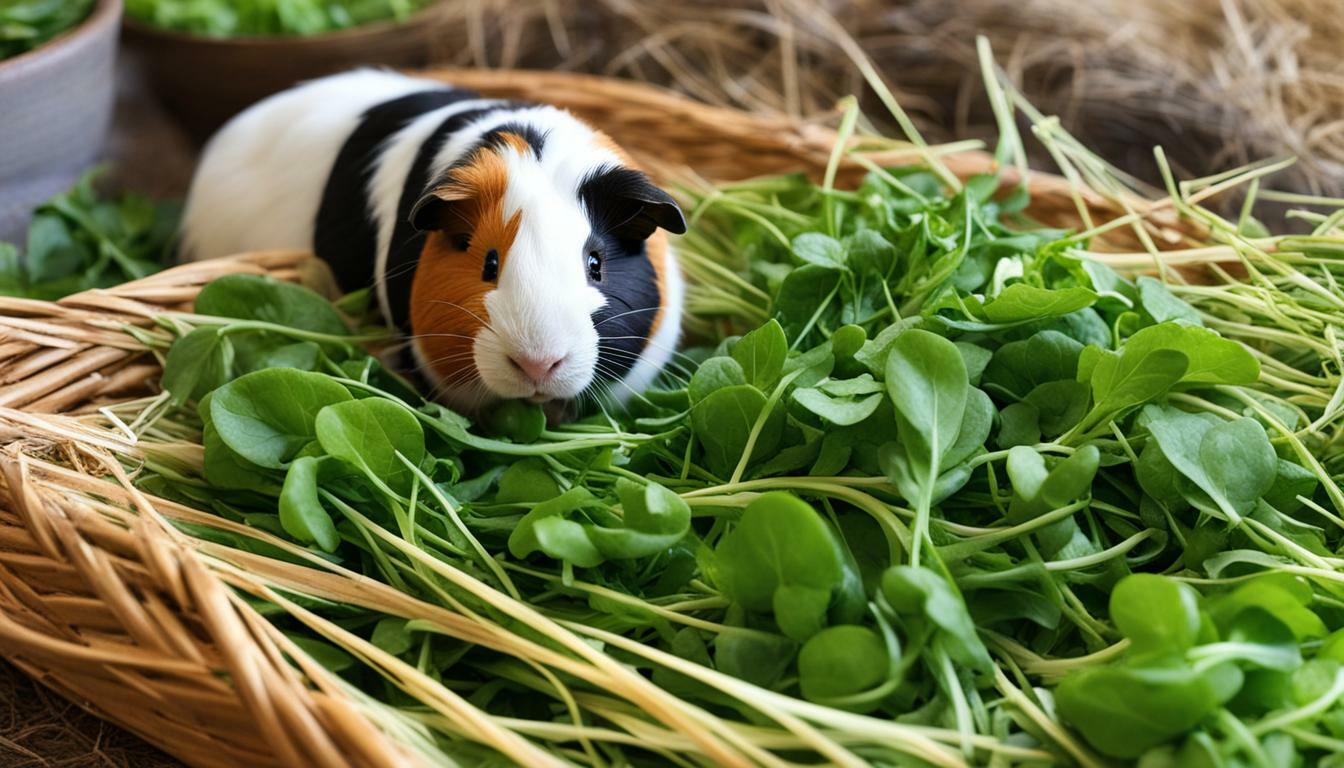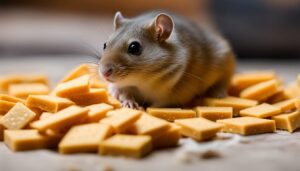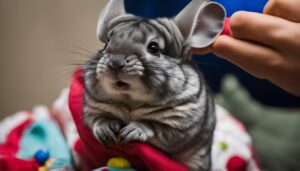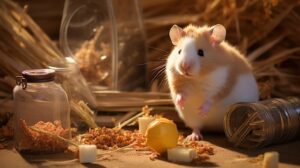Guinea pigs can enjoy a variety of vegetables, but can they eat watercress? In this article, we will explore whether watercress is a safe and nutritious addition to a guinea pig’s diet. We will also discuss the benefits, risks, and guidelines for feeding watercress to these adorable pets. So, let’s dive in and find out if watercress is a suitable vegetable for guinea pigs.
Key Takeaways:
- Watercress is safe for guinea pigs to eat in moderation.
- It is rich in essential nutrients like vitamin C, vitamin A, vitamin K, and calcium.
- Feeding watercress occasionally and in small amounts is recommended.
- It should be mixed with other vegetables to provide a balanced diet.
- Uneaten watercress should be removed from the cage to maintain hygiene.
Watercress: A Nutritious Addition to a Guinea Pig’s Diet
Watercress is not only safe for guinea pigs to consume, but it also offers a range of nutritional benefits. This leafy green vegetable is packed with essential vitamins and minerals that contribute to the overall health and well-being of guinea pigs.
One of the key advantages of watercress is its high vitamin C content. Guinea pigs, like humans, cannot produce their own vitamin C and therefore rely on their diet to meet their requirements. Watercress provides a natural and delicious source of this vital nutrient, helping to support the guinea pig’s immune system and protect against illness.
Furthermore, watercress is rich in vitamin A, vitamin K, and calcium. Vitamin A is crucial for maintaining healthy eyesight and vision, while vitamin K is essential for blood clotting. Calcium, on the other hand, is necessary for strong bones and teeth. By incorporating watercress into their diet, guinea pigs can benefit from these valuable nutrients.
It is important to note that while watercress is highly nutritious, it should be fed in moderation. Feeding excessive amounts of watercress can lead to digestive issues and acidity in guinea pigs. To ensure a balanced diet, it is recommended to offer watercress occasionally and in small amounts, mixed with other vegetables. Additionally, any uneaten watercress should be removed from the cage promptly to maintain cleanliness and prevent bacterial growth.
| Nutrient | Benefits for Guinea Pigs |
|---|---|
| Vitamin C | Boosts immune function, prevents illness |
| Vitamin A | Maintains healthy eyesight and vision |
| Vitamin K | Aids in blood clotting |
| Calcium | Promotes strong bones and teeth |
Overall, watercress can be a valuable addition to a guinea pig’s diet, providing essential nutrients and supporting their overall health. By offering watercress in moderation and ensuring a varied diet, guinea pig owners can help their furry companions thrive.
The Importance of Vitamin C for Guinea Pigs
Guinea pigs have a unique need for vitamin C, and watercress can help fulfill this essential nutritional requirement. Vitamin C plays a crucial role in maintaining the health of guinea pigs by boosting their immune system, aiding in wound healing, and supporting the production of collagen, a protein that helps form connective tissues.
Watercress is an excellent source of vitamin C, making it an ideal addition to a guinea pig’s diet. Just a small amount of watercress can provide a significant portion of their daily vitamin C needs. In fact, guinea pigs cannot produce vitamin C on their own, unlike many other animals, so they must obtain it from their diet.
The Benefits of Vitamin C
Vitamin C is crucial for guinea pig health as it acts as a powerful antioxidant, protecting their cells from damage caused by harmful substances known as free radicals. It also helps in the absorption of iron and calcium, promoting healthy bones and teeth. Additionally, vitamin C aids in the production of neurotransmitters, which are essential for proper brain function.
Feeding watercress to guinea pigs not only provides them with the necessary vitamin C but also contributes to their overall well-being. Watercress is packed with other beneficial nutrients, including vitamin A, vitamin K, and calcium, which further support guinea pig health.
| Nutrient | Benefits |
|---|---|
| Vitamin C | Boosts immune system, aids in wound healing, supports collagen production |
| Vitamin A | Improves eyesight and vision, maintains healthy skin and mucous membranes |
| Vitamin K | Aids in blood clotting, supports bone health |
| Calcium | Essential for strong bones and teeth, helps in muscle function |
It is important to note that while watercress is a valuable addition to a guinea pig’s diet, it should be fed in moderation. Feeding too much watercress can lead to digestive issues and acidity. It is recommended to offer watercress occasionally and in small amounts, mixed with other vegetables, to maintain a balanced and nutritious diet.
Lastly, to ensure the health and hygiene of your guinea pig, any uneaten watercress should be promptly removed from their cage. This will prevent the growth of bacteria and maintain a clean living environment for your furry friend.
Watercress and its Health Benefits for Guinea Pigs
Incorporating watercress into your guinea pig’s diet can have numerous positive effects on their overall health and well-being. This leafy green vegetable is packed with essential nutrients that support their immune system, aid in digestion, and promote optimal cardiovascular health. Let’s explore the health benefits of watercress for guinea pigs in more detail.
Rich in Nutrients
Watercress is a nutritional powerhouse for guinea pigs. It is an excellent source of vitamin C, which is essential for their overall health. Vitamin C helps to boost their immune system and supports the production of collagen, which is crucial for maintaining healthy skin, bones, and blood vessels. Additionally, watercress contains vitamin A, vitamin K, and calcium, all of which contribute to guinea pigs’ well-being.
Promotes Digestive Health
The high fiber content in watercress can aid in digestion and prevent constipation in guinea pigs. It helps to maintain a healthy gut by promoting regular bowel movements and preventing the buildup of harmful bacteria. By including watercress in their diet, you can help ensure the smooth functioning of their digestive system.
Supports Cardiovascular Health
Watercress is known for its heart-healthy properties. It contains antioxidants and compounds that can help reduce the risk of cardiovascular disease in guinea pigs. Regular consumption of watercress may help lower cholesterol levels, improve blood circulation, and reduce inflammation, thus supporting the overall cardiovascular well-being of your furry friend.
| Benefits of Watercress for Guinea Pigs: |
|---|
| Keeps them hydrated |
| Prevents chronic diseases |
| Eliminates free radicals |
| Reduces cancerous growths |
| Maintains cardiovascular health |
| Low cholesterol levels |
| Reduces inflammation |
| Aids bone growth and development |
| Boosts immune function |
| Aids in weight control |
| Improves eyesight and vision |
While watercress offers many health benefits, it is important to feed it to your guinea pig in moderation. Feeding too much watercress can lead to digestion problems and acidity. To ensure a balanced diet for your guinea pig, mix watercress with other vegetables and offer a varied selection of safe foods. Additionally, remember to remove any uneaten watercress from their cage to maintain hygiene and prevent bacterial growth. By incorporating watercress into their diet responsibly, you can help ensure that your guinea pig enjoys a happy, healthy life.
Moderation is Key: Feeding Watercress to Guinea Pigs
While watercress is beneficial for guinea pigs, it should be fed in moderation to avoid any potential health issues. Watercress is packed with important nutrients that contribute to the overall well-being of guinea pigs. It contains significant amounts of vitamin C, which is essential for their immune system and overall health. Additionally, watercress is rich in vitamins A and K, as well as calcium, which help support bone health. Feeding your guinea pig watercress can provide them with hydration and help prevent chronic diseases.
However, it is important to note that overfeeding watercress can lead to digestive problems and acidity in guinea pigs. To ensure a balanced diet, it is recommended to feed watercress occasionally and in small amounts. Mixing it with other vegetables is a great way to provide variety and ensure a well-rounded nutritional intake for your furry friend.
When offering watercress to your guinea pig, ensure that any uneaten portions are promptly removed from their cage. This will help maintain hygiene and prevent bacterial growth. It is best to serve fresh, clean watercress to your guinea pig to ensure optimal health.
| Nutritional Benefits of Watercress for Guinea Pigs: | Recommended Feeding Guidelines: |
|---|---|
|
|
Feeding watercress to your guinea pig can be a nutritious addition to their diet. However, it is crucial to exercise caution and moderation to ensure their well-being. By following these feeding guidelines and providing a balanced diet, you can help your guinea pig thrive and maintain optimal health.
Mixing Watercress with Other Vegetables
To ensure a well-rounded diet, consider mixing watercress with other safe vegetables that guinea pigs can consume. This will not only provide them with a variety of flavors and textures but also contribute to a balanced nutritional intake. Below is a list of some safe vegetables that can be mixed with watercress:
- Carrots: Rich in beta-carotene and vitamin A, carrots are a popular choice for guinea pigs. They provide a sweet crunch that complements the peppery taste of watercress.
- Bell Peppers: Colorful and crunchy, bell peppers are packed with vitamin C and can add a refreshing flavor to the mix.
- Cucumbers: Hydrating and low in calories, cucumbers are a great addition to any guinea pig’s diet. They add a cool and refreshing element to the mix.
- Zucchini: With its mild flavor and high water content, zucchini is a great choice for mixing with watercress. It is also a good source of vitamin C and fiber.
Remember to introduce new vegetables gradually, as sudden changes in diet can upset a guinea pig’s digestive system. Start by offering small amounts and observe their reaction. If they tolerate the mix well, you can gradually increase the portion size.
Table: Safe Vegetables to Mix with Watercress
| Vegetable | Nutritional Benefits |
|---|---|
| Carrots | Rich in beta-carotene and vitamin A |
| Bell Peppers | High in vitamin C |
| Cucumbers | Hydrating and low in calories |
| Zucchini | Good source of vitamin C and fiber |
By mixing watercress with other vegetables, you can create a nutritious and flavorful blend that will keep your guinea pigs satisfied and healthy. Remember to provide fresh water and remove any uneaten vegetables from their cage to ensure their hygiene and well-being.
Removing Uneaten Watercress to Maintain Hygiene
It is essential to remove any uneaten watercress from your guinea pig’s cage to avoid potential hygiene issues. Guinea pigs are known for their love of fresh vegetables, including watercress, but they may not eat all of the food provided to them. Leaving uneaten watercress in their cage can lead to bacterial growth, which can cause health problems for your furry friend. Regular cleaning and removing any leftover food is an important part of maintaining a clean and healthy living environment for your guinea pig.
To ensure proper hygiene, you should check your guinea pig’s cage daily and remove any uneaten watercress. Cleaning the cage regularly helps prevent illnesses and ensures a fresh and comfortable living space for your pet. Additionally, it is important to provide your guinea pig with clean, fresh water daily to keep them properly hydrated.
In order to make it easier to identify and remove uneaten watercress, you can consider using a separate dish or container for their vegetables. This can help prevent the watercress from getting mixed with their bedding or hay, making it easier to remove any leftovers. By maintaining good hygiene practices and removing uneaten watercress promptly, you can help prevent potential health issues and keep your guinea pig happy and healthy.
Table: Hygiene Tips for Guinea Pig Pet Care
| Hygiene Tips |
|---|
| Remove uneaten watercress daily |
| Clean the cage regularly |
| Provide fresh, clean water daily |
| Consider using a separate dish for vegetables |
By following these hygiene tips, you can ensure that your guinea pig remains healthy and happy. Remember, a clean living environment and proper nutrition are essential for their overall well-being. With a little extra care and attention, you can provide your guinea pig with the best possible pet care.
Potential Risks of Overfeeding Watercress
While watercress is beneficial, overfeeding can lead to digestive issues and acidity in guinea pigs. It is essential to provide a balanced diet that includes a variety of vegetables to ensure optimal health for these small pets.
Guinea pigs have sensitive digestive systems that rely on a consistent and appropriate diet. Feeding them excessive amounts of watercress can result in gastrointestinal problems such as diarrhea and bloating. Additionally, watercress contains oxalic acid, which can contribute to the formation of bladder stones in guinea pigs if consumed excessively.
To avoid these potential risks, it is recommended to offer watercress as an occasional treat rather than a staple food in their diet. Mix small amounts of watercress with other vegetables to provide a diverse range of nutrients. This will ensure that guinea pigs receive the necessary vitamins and minerals without overloading their system.
Furthermore, it’s important to monitor the amount of watercress consumed by guinea pigs and remove any uneaten portions promptly. Leaving uneaten watercress in their cage can lead to bacterial growth, which can negatively impact their health. By practicing good hygiene and removing any uneaten food, you can maintain a clean living environment for your guinea pigs.
Table: Safe Vegetables for Guinea Pigs
| Vegetable | Serving Size | Frequency |
|---|---|---|
| Watercress | Small amounts | Occasionally |
| Carrots | 1-2 baby carrots | Daily |
| Bell Peppers | 1-2 slices | Daily |
| Cucumbers | 2-3 slices | 2-3 times per week |
Remember, when it comes to feeding your guinea pigs, moderation is key. By providing a well-rounded diet and limiting the amount of watercress, you can help ensure the health and well-being of these adorable pets.
Guinea Pigs and a Balanced Diet for Optimal Health
Providing a balanced diet is crucial for maintaining the overall health and well-being of your guinea pig. This includes offering a variety of nutritious foods that meet their dietary requirements. When it comes to guinea pig nutrition, vegetables play a significant role, providing essential vitamins and minerals that support their immune system, promote proper growth, and help prevent chronic diseases.
Watercress is one such vegetable that can be a nutritious addition to your guinea pig’s diet. It is packed with vital nutrients, including vitamin C, vitamin A, vitamin K, and calcium. These nutrients are essential for guinea pigs as they assist in various bodily functions, such as maintaining healthy bones, supporting cardiovascular health, and boosting immune function. Additionally, the high water content of watercress can help keep your guinea pig hydrated.
However, it is important to remember that moderation is key. While watercress is beneficial, feeding too much of it can lead to digestion problems and acidity in guinea pigs. Therefore, it is recommended to feed watercress occasionally and in small amounts, mixed with other vegetables to provide a balanced nutritional intake. Variety is essential in a guinea pig’s diet, so consider offering a range of vegetables to ensure they receive all the necessary nutrients.
| Benefits of Watercress for Guinea Pigs |
|---|
| • Aids digestion |
| • Promotes cardiovascular health |
| • Supports immune function |
| • Helps maintain healthy bones |
Remember to remove any uneaten watercress from your guinea pig’s cage to maintain good hygiene and prevent bacterial growth. By providing a balanced diet that includes watercress, along with other vegetables and appropriate pellets, you can ensure that your guinea pig receives the necessary nutrients for optimal health and well-being.
Conclusion
Including watercress in your guinea pig’s diet, in moderation, can contribute to their overall health and nutrition. Watercress is packed with essential nutrients like vitamin C, vitamin A, vitamin K, and calcium, which are vital for guinea pig health. These nutrients help keep your furry friend hydrated, support their immune system, aid in bone growth, and promote cardiovascular health. Additionally, watercress has antioxidant properties that can eliminate harmful free radicals and reduce the risk of chronic diseases.
While watercress offers numerous benefits, it is important to feed it to your guinea pig in small amounts. Overfeeding can lead to digestive issues and increased acidity levels. To ensure a balanced diet, mix watercress with other vegetables to provide a variety of nutrients. Offering a diverse range of safe foods will help meet your guinea pig’s nutritional needs and prevent boredom with their diet.
Remember to remove any uneaten watercress from your guinea pig’s cage to maintain hygiene. Uneaten food can quickly spoil and lead to bacterial growth, which can be harmful to your pet’s health. By practicing good pet care, you can ensure a clean living environment for your guinea pig and reduce the risk of illness.
In conclusion, watercress can be a valuable addition to your guinea pig’s diet when fed in moderation. Its nutrient-rich composition offers numerous health benefits, but it is crucial to avoid overfeeding and to provide a varied diet. By prioritizing your guinea pig’s nutrition, you can support their overall well-being and help them live a happy and healthy life.
FAQ
Can guinea pigs eat watercress?
Yes, guinea pigs can eat watercress in moderation.
Why is watercress a nutritious addition to a guinea pig’s diet?
Watercress is rich in nutrients such as vitamin C, vitamin A, vitamin K, and calcium, which are all important for the health of guinea pigs.
What is the importance of vitamin C for guinea pigs?
Vitamin C is crucial for the health of guinea pigs, and watercress can help meet their vitamin C requirements.
What are the health benefits of watercress for guinea pigs?
Watercress can aid digestion, promote cardiovascular health, support immune function, and provide other health benefits for guinea pigs.
How should watercress be fed to guinea pigs?
Watercress should be fed occasionally and in small amounts to prevent digestive issues. It is best mixed with other vegetables for a balanced diet.
Can watercress be mixed with other vegetables?
Yes, it is recommended to mix watercress with other vegetables to provide a varied and balanced nutritional intake for guinea pigs.
Should uneaten watercress be removed from the cage?
Yes, it is important to remove uneaten watercress from the cage to maintain hygiene and prevent bacterial growth.
What are the potential risks of overfeeding watercress to guinea pigs?
Overfeeding watercress can lead to digestion problems and acidity in guinea pigs, so it is important to feed it in moderation.
Why is a balanced diet important for guinea pigs?
A balanced diet is essential for the optimal health of guinea pigs, and it should include a variety of safe and nutritious food options.




